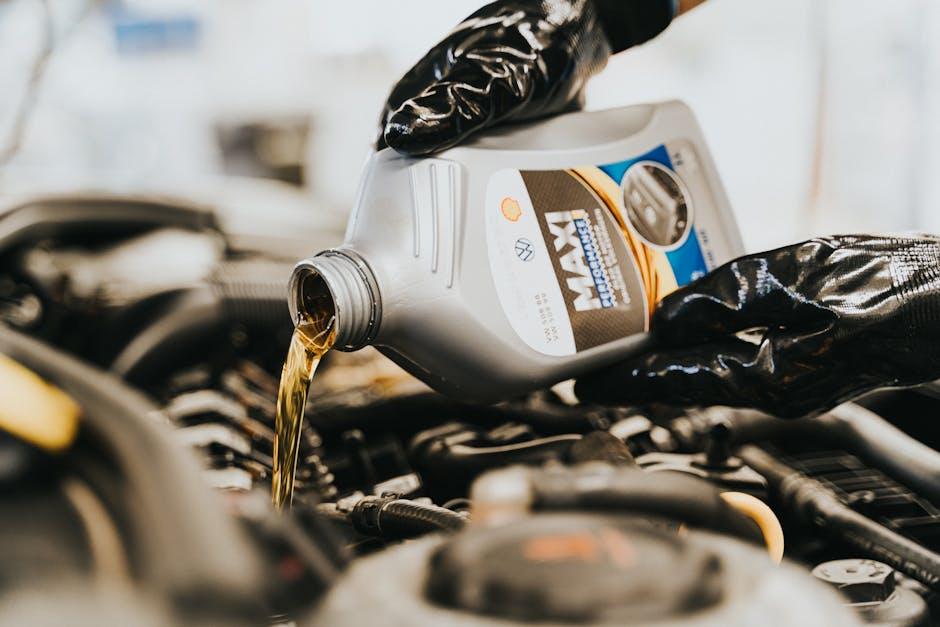Beneath the sleek hood of your vehicle lies a vital lifeblood that keeps its engine humming smoothly: motor oil. Choosing the right motor oil might seem like a simple task, but with a dizzying array of options and specifications, it can quickly become a perplexing decision. Understanding how to navigate these choices is essential not only for protecting your engine but also for enhancing performance and longevity. In this article, we break down the essentials of motor oil selection, helping you make an informed choice tailored to your vehicle’s needs and driving habits. Whether you’re a seasoned car enthusiast or a casual driver, the right oil choice can make all the difference on the road.
Table of Contents
- Understanding Motor Oil Types and Their Benefits
- Decoding Viscosity Ratings for Optimal Engine Performance
- Synthetic vs Conventional Oil Which One Suits Your Vehicle
- The Role of Additives in Enhancing Oil Efficiency
- Interpreting Manufacturer Recommendations and Warranty Requirements
- Tips for Checking and Changing Your Motor Oil Safely
- Q&A
- The Conclusion

Understanding Motor Oil Types and Their Benefits
Choosing the perfect motor oil requires understanding the main types available: conventional, synthetic, and high-mileage oils. Conventional oil is the traditional choice, suitable for everyday driving with moderate engine temperatures and wear. Synthetic oil offers enhanced performance with superior protection under extreme conditions, ideal for turbocharged or high-performance engines. High-mileage oils contain special additives to care for older engines by reducing leaks and minimizing oil consumption. Each oil type brings unique benefits tailored to your vehicle’s needs and driving style.
- Conventional Oil: Cost-effective, good for standard, everyday vehicles.
- Synthetic Oil: Excellent thermal stability, better engine cleanliness.
- High-Mileage Oil: Designed to protect seals, reduce engine wear.
| Oil Type | Ideal for | Main Benefit |
|---|---|---|
| Conventional | Older vehicles, daily drivers | Affordable and reliable |
| Synthetic | Performance & turbo engines | Max engine protection |
| High-Mileage | Engines with 75,000+ miles | Seal conditioning and reduced leaks |

Decoding Viscosity Ratings for Optimal Engine Performance
Understanding the viscosity rating is crucial for maintaining your engine’s efficiency and longevity. Viscosity refers to the oil’s resistance to flow, and it directly impacts how well the oil lubricates engine components at varying temperatures. For instance, a 5W-30 oil means it flows like a 5-weight oil in cold conditions (the “W” stands for winter), ensuring easy starts, and acts like a 30-weight oil at operating temperatures, providing sufficient protection when your engine is hot. Using the wrong viscosity can lead to poor lubrication, increased wear, or even engine damage.
When selecting the right oil, consider these factors:
- Climate: Colder climates generally require oils with lower “W” numbers for better cold starts.
- Engine Type: High-performance engines might need oils with higher viscosity at operating temperatures.
- Manufacturer Recommendations: Always check your vehicle’s manual to match the specified viscosity.
| Viscosity Grade | Ideal Use | Temperature Range |
|---|---|---|
| 0W-20 | Fuel efficient, modern engines | -35°C to 40°C |
| 5W-30 | All-purpose, most gasoline engines | -30°C to 45°C |
| 10W-40 | Older engines, hot climates | -25°C to 50°C |

Synthetic vs Conventional Oil Which One Suits Your Vehicle
When deciding between synthetic and conventional oil, consider your vehicle’s age, driving habits, and engine demands. Synthetic oil offers superior lubrication, better performance in extreme temperatures, and enhanced protection against engine wear. It’s ideal for high-performance engines, turbocharged vehicles, or those driven in harsh climates. On the other hand, conventional oil is a budget-friendly option that adequately serves standard engines with moderate driving conditions. It delivers reliable protection but typically requires more frequent changes.
To help you evaluate, here’s a quick comparison:
| Aspect | Synthetic Oil | Conventional Oil |
|---|---|---|
| Price | Higher | Lower |
| Engine Protection | Superior | Good |
| Change Interval | Longer (7,500-10,000 miles) | Shorter (3,000-5,000 miles) |
| Temperature Performance | Excellent | Moderate |
- Choose synthetic if you want longer oil life, better fuel efficiency, and high-stress engine protection.
- Opt for conventional if you drive a standard engine, want lower upfront costs, and don’t mind more frequent oil changes.

The Role of Additives in Enhancing Oil Efficiency
Modern motor oils are more than just lubricants; they are sophisticated blends infused with specialized additives designed to maximize engine performance and longevity. These additives serve multiple purposes: from reducing friction and wear, preventing corrosion, to keeping engines clean by dispersing sludge and varnish deposits. Without these compounds, even the highest quality base oil would struggle to maintain optimal efficiency under extreme temperatures and pressures.
Understanding the various types of additives can empower you to make smarter choices when selecting your next motor oil. Common categories include:
- Detergents: Keep internal engine parts free from harmful deposits.
- Antioxidants: Inhibit chemical breakdown that leads to oil thickening.
- Friction Modifiers: Improve fuel economy by reducing resistance between moving parts.
- Corrosion Inhibitors: Protect metal surfaces from rust and acid damage.
| Additive | Function | Benefit |
|---|---|---|
| Detergents | Clean engine surfaces | Improves combustion efficiency |
| Antiwear Agents | Reduce metal contact | Extends engine life |
| Dispersants | Prevent deposit buildup | Maintains oil flow |

Interpreting Manufacturer Recommendations and Warranty Requirements
Every vehicle manufacturer designs their engines with specific lubrication needs in mind, which is why adhering to their guidance is crucial for engine longevity. When selecting motor oil, look beyond the label and dive into your car’s owner manual, where you’ll find vital information on the recommended oil viscosity, performance standards, and oil change intervals tailored for your engine model. Ignoring these recommendations can lead to decreased efficiency or even damage, potentially voiding your warranty. Keep in mind that modern engines often require oils meeting stringent specifications such as API SN, SP, or ILSAC GF-6, which manufacturers list to maintain optimal engine health.
Additionally, warranty terms often stipulate that only approved oil types be used—primarily to prevent claims disputes and ensure your coverage remains intact. Here are some handy pointers to consider:
- Check for certification labels: Oils certified by organizations like API or ACEA often align with manufacturer specs.
- Viscosity matters: Use the exact grade recommended to avoid improper lubrication.
- Document your oil changes: Keeping a log with dates and oil type can help safeguard your warranty claims.
| Manufacturer | Recommended Viscosity | Common Oil Specification |
|---|---|---|
| Toyota | 0W-20 | API SN/CF |
| Ford | 5W-30 | API SP |
| BMW | 5W-40 | ACEA A3/B4 |

Tips for Checking and Changing Your Motor Oil Safely
Before you dive under the hood, make sure your car is parked on a level surface and the engine is cool—this prevents burns and ensures an accurate oil level reading. Start by pulling out the dipstick, wiping it clean with a lint-free cloth, then reinserting it fully before pulling it out again to check the oil level. Look for oil that is clear and amber-colored; dark, gritty oil indicates it’s time for a change. Always consult your vehicle’s owner’s manual for the exact oil specifications and the recommended interval between changes.
When changing your oil, wear gloves to protect your hands from contaminants, and have a drain pan ready to catch the old oil. After draining, replace the oil filter to ensure your engine stays contaminant-free. Refill the engine with the correct type and amount of oil, then run the engine briefly before rechecking the level—topping off if necessary. For quick reference, here’s a basic guide to common oil viscosities and their recommended climates:
| Viscosity | Best For | Temperature Range (°F) |
|---|---|---|
| 5W-30 | Most cars, all seasons | -20 to 100 |
| 10W-40 | Older engines, warmer climates | 10 to 110 |
| 0W-20 | Newer engines, cold climates | -30 to 80 |
- Use proper tools: oil filter wrench, funnel, and socket set.
- Dispose of oil responsibly: take used oil to a recycling center.
- Check for leaks: inspect under the vehicle after changing oil.
Q&A
Q&A:
Q1: Why is choosing the right motor oil important for my car?
A1: Think of motor oil as your engine’s lifeblood. It lubricates, cools, and cleans vital parts, ensuring smooth performance and longevity. Using the wrong oil can lead to poor efficiency, increased wear, or even engine damage.
Q2: What do those numbers on the oil bottle mean? (e.g., 5W-30)
A2: Those numbers indicate the oil’s viscosity, or thickness, at different temperatures. The first number with a “W” (winter) shows how the oil flows in cold temperatures, while the second number reflects its thickness at operating temperature. Choosing the right viscosity helps your engine start smoothly and stay protected throughout varying conditions.
Q3: Should I pick synthetic or conventional motor oil?
A3: Synthetic oils are engineered for better performance—they resist breakdown, handle extreme temperatures, and keep your engine cleaner. Conventional oils are typically less expensive and suitable for older or less demanding vehicles. Your car’s manual usually recommends the best choice for your model.
Q4: How often should I change my motor oil?
A4: This depends on your driving habits, oil type, and vehicle specifications. Synthetic oils often allow longer intervals between changes, sometimes up to 10,000 miles, while conventional oils may need changing every 3,000 to 5,000 miles. Always follow your manufacturer’s recommendations.
Q5: What about oil additives—are they necessary?
A5: Modern motor oils already contain additives to enhance performance, such as detergents and anti-wear agents. While some aftermarket additives can be beneficial for specific issues, most drivers won’t need them if using quality oil and maintaining regular changes.
Q6: Can using the wrong oil damage my engine?
A6: Yes, using oil with incorrect viscosity or failing to meet the required specifications can lead to inadequate lubrication. This might cause increased engine wear, reduced efficiency, or overheating. Always refer to your owner’s manual to ensure compatibility.
Q7: How do I know which oil specifications to look for?
A7:
The Conclusion
Choosing the right motor oil isn’t just about keeping your engine lubricated—it’s about ensuring a smoother ride, extending your vehicle’s life, and protecting your investment. With so many options on the shelves, understanding your car’s needs and the oil’s specifications transforms a simple choice into a smart decision. By tuning in to the details and trusting reliable guidance, you empower your engine to perform at its best. After all, the right motor oil isn’t just fuel for your car—it’s peace of mind on every mile.

